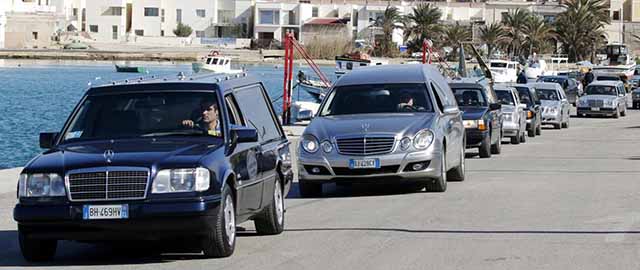
A kid waves goodbye from behind the window, smiles. The railway station, Milano Centrale. The car that carries off the last of the refugees is a gray station wagon – like the one on Lampedusa, Italy’s southernmost island, that bear their coffins.
That’s Europe. “We are here talking of Schengen. Of visas, quotas. But these aren’t migrants, these are men and women fleeing a war,” Desio De Meo says sharply. “Hosting them is not an act of kindness, it’s a legal duty.” Logistical manager of the NGO Emergency for fifteen years, he has been building hospitals in the paths of tanks and the midst of famines, always according to the same standard: “I would have been willing to be treated there myself.” He is now the manager of Milan’s municipal reception center for Syrians. He makes me a coffee in one of its large, bright rooms, orderly – and deserted: today’s the last day, the center is closing. Just as empty rafts are running ashore on Lampedusa. Their passengers lie now somewhere on the Mediterranean seabed. “We are here counting the number of miles we can sail to rescue them, thirty or thirty-one. But these people are so desperate to flee, they’ll even go to Iraq.”
And yet, suddenly, they are all gone.
In the last months, whoever happened to be in Milan would see Syrians there, encamped in the central station. By the dozens. And then the hundreds. All with no papers, all bound toward northern Europe, to Sweden, Germany. The 55,494 who stopped here stayed for an average of four days: only 213 of them applied for asylum. But now there’s nobody left. I came to Milan to ask questions, and instead I’m expected to answer them: volunteers and aid workers are all wondering where the Syrians are.
The only certainty is that the war is still raging: and with war come refugees. It’s not so much about Syrians leaving Syria, since five million people, a quarter of the population, are now abroad: those who decided to leave, have already left. Those Syrians who are about to leave are rather doing so from the countries where they’ve found shelter – the neighboring countries: Turkey, Lebanon, Jordan, Iraq, where 97 percent of refugees live. After four years, not only does the war continue, but there are two regimes instead of one, Bashar al-Assad’s and the jihadists’. And many Syrians have started to plan lives elsewhere. In Europe. In Sweden. Germany. Fabio Bucciarelli has just taken some of their portraits in Mersin, the main port of Turkey. Packed into old houses on the sea by the dozens. The hundreds. But he had to photograph them with backs turned: in the dark. Since they are in the hands of traffickers.
That, for now, is the sole achievement of Operation Triton, successor to Operation Mare Nostrum. Now patrol boats, rescue boats, must keep within thirty miles of the coast. And so traffickers use cargo vessels instead of rafts, which are cheaper. That’s the only achievement of the attempts to stop landings: routes have changed, making the trip longer – and more dangerous. Last year, you would pay 1,000 euro. Today it’s 6,000.
Nobody’s given up in Mersin. They’re just borrowing money from relatives and friends.
“Traffickers exist because crossing is illegal. And it’s illegal because of Schengen,” says Stefano Liberti, one of the first journalists to cast a light on European borders. Especially considering that when they survive and arrive, he says, when their asylum application is finally examined, nearly all migrants get some form of protection. “They aren’t killed by traffickers, they’re killed by our laws.” When we swim in the Mediterranean sea, we swim among 21,439 corpses.
Advertisements for ways of reaching Europe with neither passport nor visa can be found on facebook, or on walls near the port, in the thousand Mersins of the world – it’s a market where the only ones forced into hiding are the customers. It’s an organized phenomenon that we insist on treating as improvised, and a structural one that we insist on treating as temporary, an emergency. This is a matter of convenience. Convenience for those who can speak of an invasion of strangers, of the poor, of Arabs, of potential terrorists, those who exploit our fear, our insecurity, without ever showing us the ready and empty rooms of Milan. Most of all, convenience for those who’ve figured out how to turn a refugee crisis into money. Municipalities pay back to reception centers an average of 45 euro per guest per day, plus other funds. And plus private donations. And not everybody is like Annamaria Lodi, who takes care of the refugees as if they were her brothers, her children, with her skilled, bilingual staff. Others are like the manager of the Tropicana, a nightclub in Ragusa, Sicily, where beds are line the dance floor. In Italy there are CARA centers for asylum seekers, SPRAR centers, which should, as the acronym suggests, be much more, offering “protection systems” geared toward social inclusion, and, finally, there are CAS centers, originating at the time of the influx of refugees from the Arab Spring as centers for extraordinary reception. Of 62,000 guests total, currently 32,000 migrants are housed in centers of this kind. Usually repurposed gyms. Or night clubs. But they cost just as much as other centers.
“And if you don’t provide anything, any service beyond soup for dinner, you can make money out of it,” Annamaria Lodi says. The true emergency is in Lebanon, where refugees, Syrians and Palestinians alike, now amount to more than half of the population – and while ISIS is infiltrating the north, Israel plans to strike Hezbollah in the south. But to be able to call it an “emergency,” in Italy, is convenient: the greater the urgency, the more funds. And the less oversight. Sometimes, adults are passed off as kids to get the extra funds allocated to minors.
In 2014, the dead numbered 3,419. Our 9-11. Only, we were the ones forcing refugees to resort to traffickers. Hijackers into death.
Francesca’s new book, Syrian Dust, will be released in the US in September by Seven Stories Press
Articolo Precedente
Florence – A photo

Articolo Successivo
Palazzi del governo, 30 milioni per gli affitti. Cartoline dagli sprechi di Stato – Gallery





